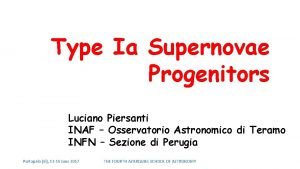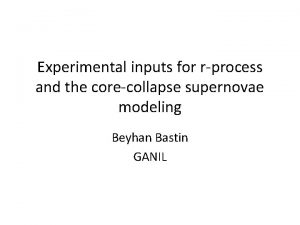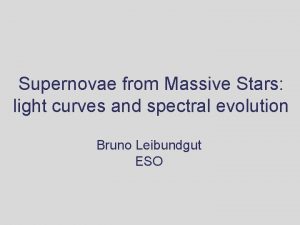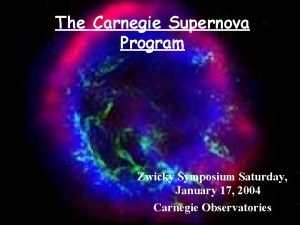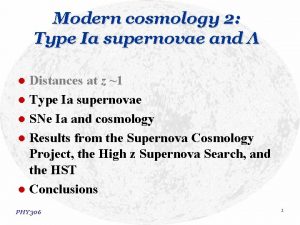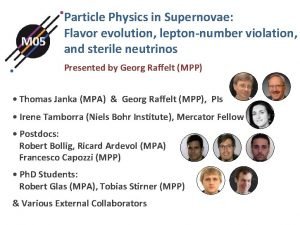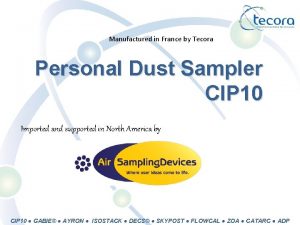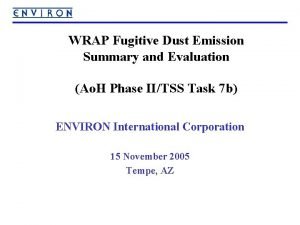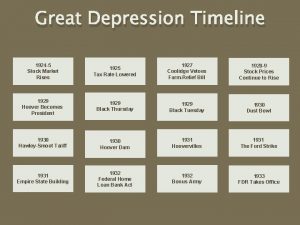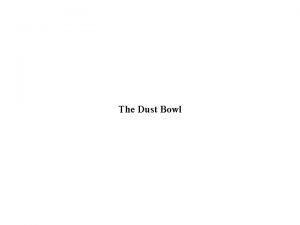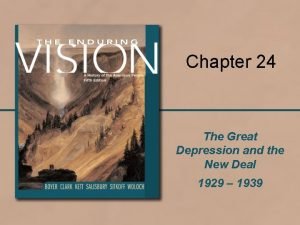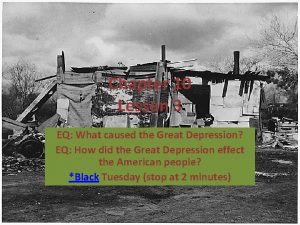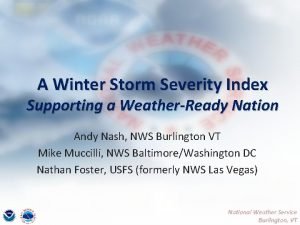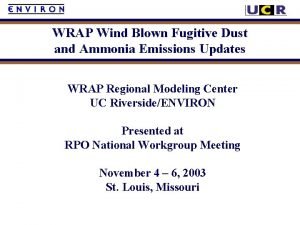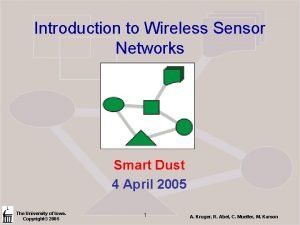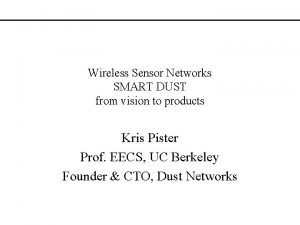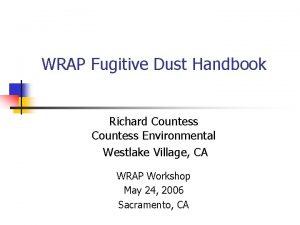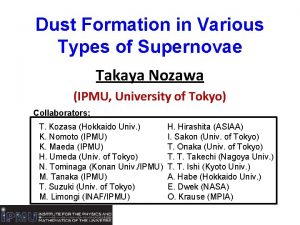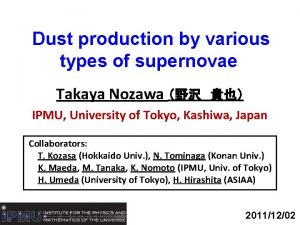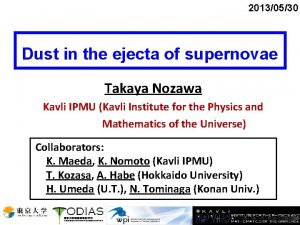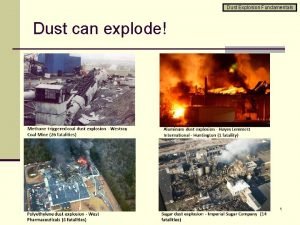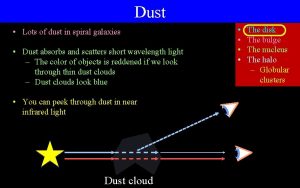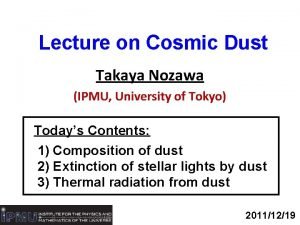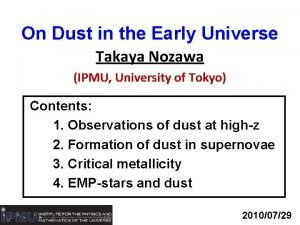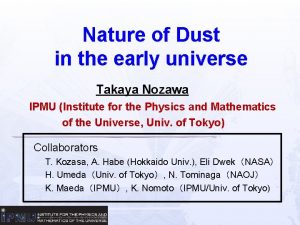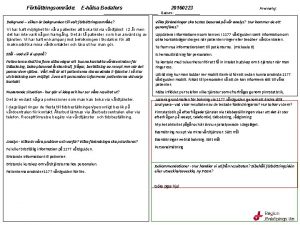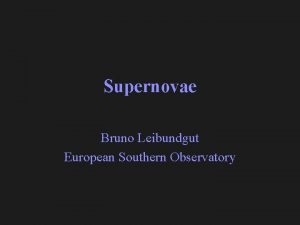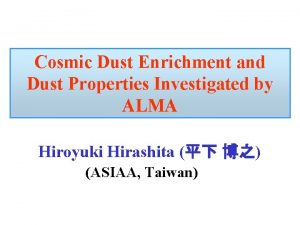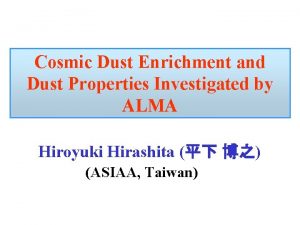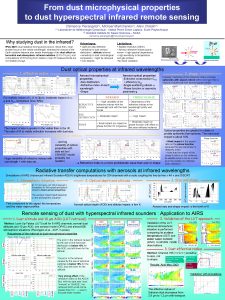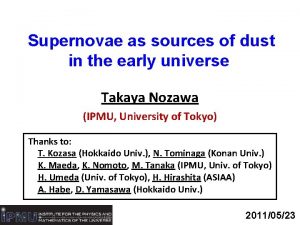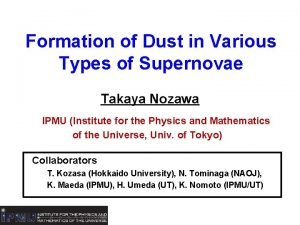20160223 Properties of dust ejected from supernovae Takaya

































- Slides: 33

2016/02/23 Properties of dust ejected from supernovae Takaya Nozawa (National Astronomical Observatory of Japan) Contents: - Introduction of dust formation in SNe - Properties of dust from theoretical works on dust formation and processing in SNe - Observations of dust composition and size in SNe

1 -1. Introduction 〇 Supernovae (SNe) are major sources of dust? - abundant metal (metal : N > 5) - low temperature (T < ~2000 K) - high density (ni > ~106 cm-3) - mass-loss winds of AGB stars - expanding ejecta of SNe ‐ contribution of dust mass from AGB stars and SNe N(SNe) / N(AGB stars) ~ 0. 05 -0. 1 (Salpeter IMF) Mdust = 0. 01 -0. 05 Msun per AGB star (e. g. , Zhukovska & Gail 2008) Mdust = 0. 1 -1. 0 Msun per SN (e. g. , Nozawa+2003, 2007) ‐ huge amounts of dust grains (>108 Msun) at redshift z > 5 ➔ 0. 1 Msun of dust per SN is needed to be ejected (Dwek+2007) what composition, size, and mass of dust are ejected by SNe?

1 -2. Emission and absorption efficiency of dust ○ Thermal radiation from a dust grain Fλ ∝ 4πa 2 Qemis(a, λ) πBλ(Tdust) # Qemis = Qabs carbon silicate (Qemis/a) is independent of a Fλ ∝ 4πa 3 (Qemis[a, λ]/a) πBλ(Tdust) ∝ 4 Mdust κemis(λ) πBλ(Tdust) ➔ IR emission is derived given Mdust, κabs, and Tdust

1 -3. Summary of observed dust mass in CCSNe missing cold dust? young SNRs Matsuura+2011 Type II-P SNe Balow+2010 Gomez+2012 swept-up IS dust? Far-IR to sub-mm observations are essential for revealing the mass of dust grains produced in the ejecta of SNe

1 -3. Summary of observed dust mass in CCSNe missing cold dust? young SNRs Type II-P SNe swept-up IS dust? There are increasing pieces of evidence that massive dust in excess of 0. 1 Msun is formed in the ejecta of SNe

1 -4. Formation and processing of dust in SNe Nozawa 2014, Astronomical Herald ~1 -3 yrs ~1000 yrs Destruction efficiency of dust grains by sputtering in the reverse shocks depends on their initial size The size of newly formed dust is determined by physical condition (gas density and temperature) of SN ejecta

1 -5. Achievement and issues on SN dust 〇 What we have understood is Core-collapse supernovae can produce a large amount of dust in excess of ~0. 1 Msun in the expanding ejecta 〇 What we have not understood yet is 1) when the observed massive dust was formed? ➜ Cause of difference in dust mass in MIR and FIR 2) What composition and size distribution of dust are? ➜ Critical to the yield of dust finally ejected from SNe

2. Theoretical works on formation and processing of dust in SNe

2 -1. Dust formation in Type II-P SNe Nozawa+2003, Ap. J, 598, 785 〇 SN model (Population III SNe) (Umeda & Nomoto 2002) ‐SNe II : MZAMS = 13, 20, 25, 30 Msun (E 51=1) after 600 days ‐layered elemental distribution in the metal-rich He core ‐no mixing of elements within the He-core ‐gas density: ρ ~ 10 -14 -10 -13 g/cm 3 ➜ n ~ 108 -1010 /cm 3

2 -2 -1. Grain species considered in this study 〇 dust formation theory ‐nucleation ‐grain growth taking account of chemical reaction at condensation (Kozasa & Hasegawa’ 87) # key species: gas species with the least collision frequency among reactants key species controls the kinetics of the nucleation and grain growth

2 -2 -2. Nucleation rate Steady-state nucleation rate: Js Supersaturation ratio: S

2 -2 -3. Basic equations for dust formation ・ Equation of mass conservation ・ Equation of grain growth Growth rate is independent of grain radius

2 -3. Dust formed in Type II-P SNe average radius 0. 01 μm C / O < 1 ➔ all C atoms are locked up in CO C / O > 1 ➔ all O atoms are locked up in CO condensation time ‐a variety of grain species can condense according to elemental composition in each layer ‐ condensation time: 300 -600 d after explosion ‐ average grain radii: >~0. 01 μm Nozawa+03, Ap. J, 598, 785

2 -4. Size distribution of newly formed dust Nozawa+2003, Ap. J, 598, 785 ‐C, Si. O 2, and Fe grains have lognormal-like size distribution, while the other grains have power-law size distribution ‐Size distribution summed up over all grain species is roughly described by a broken power-law with the index of -2. 5 and -3. 5 ‐Size distribution of dust in mass has a peak around 0. 1 -1 µm

Destruction of dust grains by SN reverse shocks T = (1 -2)x 104 K n. H, 0 = 0. 1 -1 cm-3 He core FS RS CD

2 -5 -1. Time evolution of SNRs

2 -5 -2. Dynamics of dust

2 -5 -3. Erosion rate of dust by sputtering

2 -6. Evolution of dust in SNRs Model : Mpr= 20 Msun (E 51=1), n. H, 0 = 1 cm-3 dust trajectories The evolution of dust heavily depends on the initial radius and composition aini = 0. 01 μm (dotted lines) ➔ completely destroyed aini = 0. 1 μm (solid lines) ➔ trapped in the shell evolution of dust radii aini = 1 μm (dashed lines) ➔ injected into the ISM Nozawa+07, Ap. J, 666, 955

2 -7. Dust mass and size ejected from SNe II Nozawa+07, Ap. J, 666, 955 SNe II-P total mass of dust surviving the destruction in Type II SNRs; 0. 07 -0. 8 Msun (n. H, 0 = 0. 1 -1 cm-3) size distribution of dust after the shock-destruction is domimated by large grains (> 0. 1 μm)

2 -8. Conclusions from theoretical works 1) When the observed massive dust was formed? ➜ within 3 years after SN explosion 2) What composition and size distribution of dust are? ‐composition: carbon, silicate, oxide, pure iron … ‐size (distribution) - at the formation ➜ a few A to ~1 µm (broken power-law) - after destruction ➜ biased to larger than ~0. 1 µm ‐dust mass - at the formation: 0. 1 -1. 3 Msun - after destruction: 0. 07 -0. 8 Msun

A-1. Dust formation in Type IIb SN ○ SN IIb model (SN 1993 J-like model) - Meje = 2. 94 Msun MZAMS = 18 Msun MH-env = 0. 08 Msun - E 51 = 1 - M(56 Ni) = 0. 07 Msun

A-2. Dependence of grain radii on SN type SN IIb SN II-P 0. 01 μm - condensation time of dust 300 -700 days after explosion - total mass of dust formed ・ 0. 167 Msun in SN IIb ・ 0. 1 -1 Msun in SN II-P Nozawa+10, Ap. J, 713, 356 - the radius of dust formed in H-stripped SNe is small ・ SN IIb without massive H-env ➔ adust < 0. 01 μm ・ SN II-P with massive H-env ➔ adust > 0. 01 μm

A-3. Destruction of dust in Type IIb SNR homogeneous CSM (ρISM = const) stellar-wind CSM (ρCSM ∝ r-2) 330 yr n. H, 1 = 30, 120, 200 /cc ➔ d. M/dt = 2. 0, 8. 0, 13 x 10 -5 Msun/yr for vw=10 km/s Almost all newly formed grains are destroyed in the hot gas that was swept up by the reverse shocks ➔ small radius of newly formed grains ➔ early arrival of reverse shock at dust-forming region Nozawa+10, Ap. J, 713, 356

A-4. IR emission from dust in Cas A SNR AKARI 90 μm image (color) ・ total mass of dust formed Mdust = 0. 167 Msun ・ shocked dust : 0. 095 Msun Md, warm = 0. 008 Msun ・ unshocked dust : Md, cool = 0. 072 Msun with Tdust ~ 40 K Nozawa+10, Ap. J, 713, 356 AKARI observation Md, cool = 0. 03 -0. 06 Msun Tdust = 33 -41 K (Sibthorpe+10) Herschel observation Md, cool = 0. 075 Msun Tdust ~ 35 K (Barlow+10)

3. Observations of composition and size of dust in SNe 1) When the observed massive dust was formed? 2) What composition and size distribution of dust?

3 -1. Revisiting dust mass formed in SN 1987 A 775 day 8515 day - dust mass ~ 0. 002 Msun Wesson+15 - dust mass ~ 0. 7 Msun - dust radius ~ 0. 2 µm large radius is required to have Tdust ~ 20 K in LMC

3 -2. Dust mass from line profiles in SN 1987 A OI 6300 Bevan & Barlow 2016 At 714 day ・ dust mass < 3 x 10 -3 Msun (< 0. 07 Msun if silicate) ・ grain radius > ~0. 6 µm

3 -3. Evolution of dust mass in SN 1987 A It seems to be difficult that dust continues to form in later epochs at which gas density is low At 615 and 714 day ・ dust mass: ~0. 4 Msun Dwek & Arendt 2015, Ap. J, 810, 75 ・ silicate-dominated

3 -4. Composition of dust formed in SNe first detection of silicate in SN silicate 775 day Wesson+15, SN 1987 A 8515 day carbon Kotak+09, SN 2004 et Matuura+2011, SN 1987 A

3 -5. Composition of dust in Cas A SNR Douvion+01 - glassy carbon - Fe. O, Al 2 O 3 Rho+08 - Mg. Si. O 3 - Fe, Fe. S, Si - Mg-silicate - Fe. O, Si. O 2 various grain species exist in each place (layer)

3 -6. Dust properties in one knot of Cas A SNR to cause large extinction, large dust mass is needed cool dust component Lee, Koo et al. 2015, Ap. J, 808, 98 Far-side is more obscured than near-side E(J-H) = 0. 23 ➜ Fe with a < 0. 01 µm (or large Si dust) Fλ ∝ 4 Mdust κemis(λ) πBλ(Tdust)

3 -7. Conclusions from observational works 1) When the observed massive dust was formed? ➜ under debate ‐dust mass gradually increases throughout 25 years ‐dust formation must be finished within a few years 2) What composition and size distribution of dust are? ‐composition: carbon, silicate, oxide, pure iron … ➜ consistent with theoretical prediction ‐size (distribution) - SN 1987 A ➜ relatively large above 0. 1 µm? - Cas A ➜ small Fe (< 0. 01 µm) or large silicon? not well constrained for the other species
 Supernovae
Supernovae Supernovae
Supernovae Supernovae
Supernovae Type ia supernovae
Type ia supernovae Supernovae
Supernovae Supernovae
Supernovae Chemical properties of citric acid
Chemical properties of citric acid Descriptive matter
Descriptive matter Personal dust sampler
Personal dust sampler From dust you came
From dust you came Dust bowl webquest
Dust bowl webquest Wrap fugitive dust handbook
Wrap fugitive dust handbook What caused the dust bowl
What caused the dust bowl Dust of snow introduction
Dust of snow introduction Methyl parathion dust
Methyl parathion dust Arthur rothstein fleeing a dust storm
Arthur rothstein fleeing a dust storm Dust bowl map
Dust bowl map Route 66 dust bowl
Route 66 dust bowl Dust bowl acrostic poem
Dust bowl acrostic poem Dust storm severity index
Dust storm severity index Wrap fugitive dust handbook
Wrap fugitive dust handbook Smart dust military
Smart dust military Reaver pro
Reaver pro Dust bowl map activity
Dust bowl map activity Smart dust
Smart dust Used to brush loose graphite and eraser dust from a drawing
Used to brush loose graphite and eraser dust from a drawing Out of the dust characters
Out of the dust characters Chalkdustdiva
Chalkdustdiva Wrap fugitive dust handbook
Wrap fugitive dust handbook Dust bowl map
Dust bowl map Dust of snow robert frost analysis
Dust of snow robert frost analysis The dust code
The dust code Pictures of the dust bowl
Pictures of the dust bowl Diseases caused by dust
Diseases caused by dust
